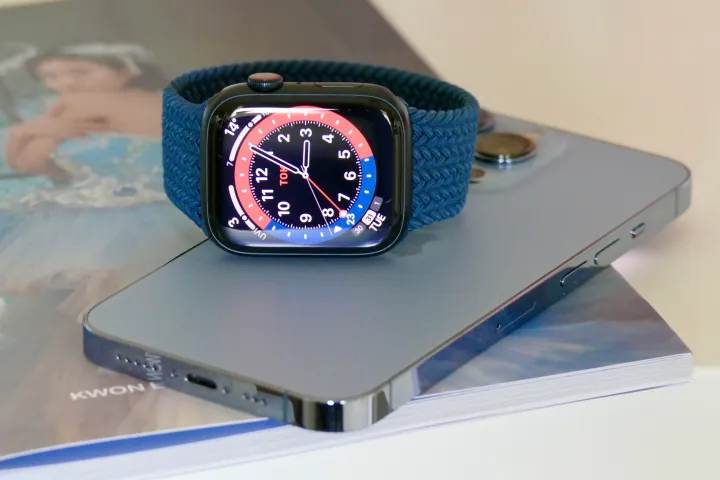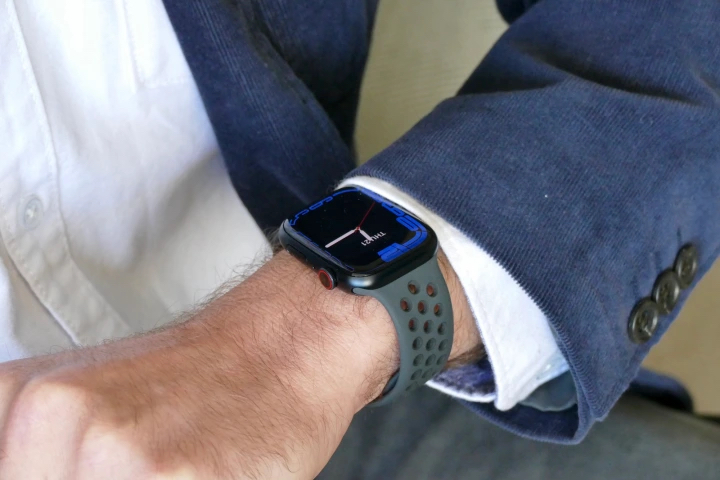Apple introduced the Apple Watch Series 7 in 2021, and it featured significant design changes from earlier models. Those changes were largely carried over to the Series 8 and Series 9. Significant changes again arrived in the Apple Watch lineup, this time with the all-new Apple Watch Series 10.
The Series 10 has many advantages, including a larger display, refined case, and various new features. Does all this make it worth upgrading from the Series 7? It’s time to find out.
Apple Watch Series 10 vs Apple Watch Series 7: specs
| Apple Watch Series 10 | Apple Watch Series 7 | |
| Sizes and dimensions | 46mm (46mm x 39mm x 9.7mm)
42mm (42mm x 36mm x 9.7mm) |
45mm (45mm by 38mm by 10.7mm)
41mm (41mm by 35mm by 10.7mm) |
| Weight | 46mm:
36.4 grams (aluminum, GPS) 35.3 grams (aluminum, GPS + Cellular) 41.7 grams (titanium) 42mm: 30 grams (aluminum, GPS) 29.3 grams (aluminum, GPS + Cellular) 34.4 grams (titanium) |
45mm:
38.8 grams (aluminum, GPS) 39.1 grams (aluminum, GPS + Cellular) 51.5 grams (stainless steel) 45.1 grams (Titanium) 41mm: 32 grams (aluminum, GPS) 32 grams (aluminum, GPS + Cellular) 42.3 grams (stainless steel) 37 grams (Titanium) |
| Color | Jet black aluminum
Rose gold aluminum Silver aluminum Slate Titanium Gold Titanium Natural Titanium |
Midnight aluminum
Starlight aluminum Green aluminum Blue aluminium (PRODUCT)RED aluminum Silver stainless steel Graphite stainless steel Gold stainless steel Titanium Space black Titanium |
| Display | Always‑On Retina LTPO3 display
Wide‑angle OLED Up to 40% brighter when viewed at an angle Edge‑to‑edge display Ion‑X front glass (aluminum cases) Sapphire front crystal (titanium cases) Up to 2000 nits maximum brightness 1 nit minimum brightness 326 pixels per inch |
Always-On Retina LTPO display
Ion‑X front glass (aluminum cases) Sapphire front crystal (stainless steel and titanium cases) Up to 1000 nits brightness 326 pixels per inch |
| Processor | S10 SiP with 64-bit dual-core processor
W3 Apple wireless chip Second-generation Ultra Wideband Quad-core Neural Engine |
S7 SiP with 64-bit dual-core processor
W3 Apple wireless chip U1 chip (Ultra Wideband) |
| Storage | 64GB | 32GB |
| Sensors | Electrical heart sensor
Third-generation optical heart sensor Ambient light sensor Water temperature sensor Depth gauge and depth app Speaker w/media playback Microphone with voice isolation Always-on altimeter Compass Waypoints, Backtrack, and elevation view High dynamic range gyroscope |
Electrical heart sensor
Third-generation optical heart sensor Ambient light sensor Speaker Microphone Altimeter Compass Waypoints, Backtrack, and elevation view Gyroscope |
| Double Tap | Yes | No |
| Battery life | Up to 18 hours
Up to 36 hours in Low Power Mode |
Up to 18 hours |
| Charging | 0-80% in 30 minutes | 0-80% in 45 minutes |
| Price | Starting at $399 (GPS only)
Starting at $499 (GPS + Cellular) |
Starting at $399 (GPS only)
Starting at $499 (GPS + Cellular) |
| Review | Apple Watch Series 10 | Apple Watch Series 7 |
Apple Watch Series 10 vs Apple Watch Series 7: design

The Apple Watch Series 10 marks a significant design departure from its predecessors, including the Series 7. Available in slightly larger 42mm and 46mm sizes, the Series 10 has a noticeably thinner and lighter profile, achieved through reengineering its internal components. This slimmed-down design allows the watch to sit comfortably and flush on the wrist, enhancing the overall wearing experience.
Apple has also refined the case material options, offering the Series 10 in titanium and aluminum. The aluminum models come in a polished jet black finish and the familiar matte silver and rose gold options. Titanium cases are available in slate, gold, and Natural finishes. This year, stainless steel cases and the vibrant Product Red color option are absent.
While the Series 10 retains the iconic Digital Crown and side button configuration, its overall aesthetic is refined elegance and subtle sophistication. Its lighter weight, larger displays, and updated finishes give it a more premium look and feel. Compared to the Series 7, which was offered in 41mm and 45mm sizes and included stainless steel as a case material, the Series 10 is a sleeker and more streamlined successor.
There are many design changes between the Series 10 and Series 7, so an making an upgrade on this point alone could be worth it.
Apple Watch Series 10 vs. Apple Watch Series 7: display

The Apple Watch Series 10 boasts a larger, more vibrant display than its predecessors, thanks to Apple’s third-generation LTPO OLED technology. This translates to a wider refresh rate range for smoother visuals and improved power efficiency, helping it outperform the Series 7 and even the Ultra 2. With a stunning peak brightness of 2,000 nits (versus the Series 7’s 1,000 nits), the Series 10 ensures exceptional clarity in direct sunlight, while its 1-nit minimum brightness provides comfortable viewing in lowlight settings.
But the display enhancements don’t stop there. Apple’s innovative wide-angle OLED technology dramatically improves off-axis viewing angles. This means the screen appears significantly brighter and more legible when glanced at from the side, which is a noticeable improvement over previous models.
The Series 10 provides many display enhancements. It is available in 42mm and 46mm versions, versus the Series 7’s 41mm and 45mm options.
Apple Watch Series 10 vs. Apple Watch Series 7: health and fitness tracking
 Andy Boxall / Digital Trends
Andy Boxall / Digital TrendsThe Series 10 and Series 7 watches have similar health and fitness features, such as Apple’s activity rings and the ability to track various workouts. Both watches support Apple Fitness+ for guided workouts and introduce Training Load, which helps users understand how the intensity of their workouts may impact their bodies over time.
They also include an ECG app for detecting high and low heart rates, sleep tracking, and cycle tracking. Both watches also support Apple’s new Vitals app, which accesses your daily heart rate, respiratory rate, wrist temperature, and sleep duration. There’s also the Mindfulness app with state-of-mind tracking.
The Series 10 offers some key improvements on the health side, however, such as nightly wrist temperature tracking and advanced cycle tracking with retrospective ovulation estimates. The wrist temperature tracking measures temperature during sleep to provide insights into overall wellness and menstrual cycle variations. The retrospective ovulation estimates combine wrist temperature data with other cycle-tracking information to estimate past ovulation times.
In many respects, the Series 10 and Series 7 offer similar fitness features. On the health-tracking side, however, the Series 10 offers improvements, especially for women.
Apple Watch Series 10 vs. Apple Watch Series 7: software and performance

While the Apple Watch Series 7 and Series 10 enjoy the benefits of the watchOS 11 update, there are a few key differences to consider. The Series 7 misses out on the offline translation capabilities of the new Apple Translate app and the dynamic category-based photo curation for watch faces, both of which are available on the Series 10. However, Series 7 users can still enjoy other exciting watchOS 11 features like the Tides app, Smart Stack, Live Activities, and Tap to Cash.
Although Apple doesn’t explicitly state the length of software support for its watches, the Series 7, now three years old, might only have a couple of years of updates left. Regarding performance, the Series 10’s S10 SiP offers a noticeable boost over the Series 7’s S7 SiP, potentially resulting in faster app launches and smoother operation. The S10 chip also allows for a more advanced display with a wider refresh rate range and improved power efficiency on the Series 10.
Apple Watch Series 10 vs. Apple Watch Series 7: battery and charging

Apple seems to be lagging in the smartwatch battery life race. While the Apple Watch Ultra models boast an impressive 36 hours, the recently released Series 10 disappoints with a mere 18 hours – the same as its predecessor, the Series 7. This pales in comparison to the Ultra line and competitors like the Google Pixel Watch 3, which offers up to 45 hours, and the Samsung Galaxy Watch 7, which provides 24 hours. In a world where consumers increasingly value longevity between charges, Apple’s 18-hour battery life for its flagship Series 10 feels decidedly outdated.
Though both Series 7 and Series 10 only promise up to 18 hours between charges, they differ in fast charging. Where it takes 45 minutes to get an 80% charge on the Series 7, that number is cut to 30 minutes on the Series 10.
Apple Watch Series 10 vs. Apple Watch Series 7: should you upgrade?

While Apple Watch upgrades often feel incremental, the leap from the Series 7 to the Series 10 is significant enough to warrant serious consideration.
Beyond the refreshed design and subtly larger display, the Series 10 introduces compelling health features like sleep apnea tracking, a faster and more efficient processor for a smoother user experience, and many other refinements.
For Series 7 owners contemplating an upgrade, the time is now — the Series 10 offers a big tangible step up in both functionality and performance.
Services Marketplace – Listings, Bookings & Reviews